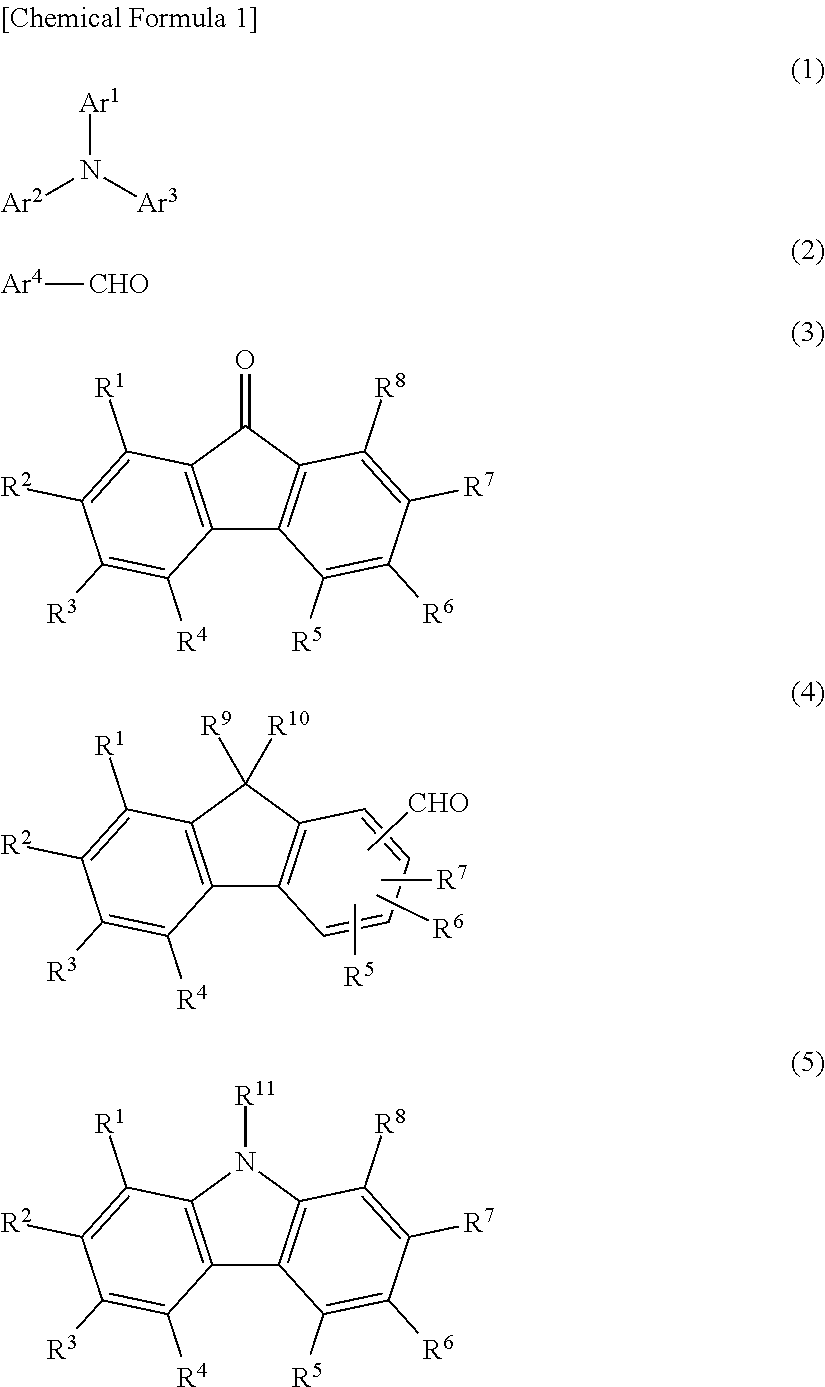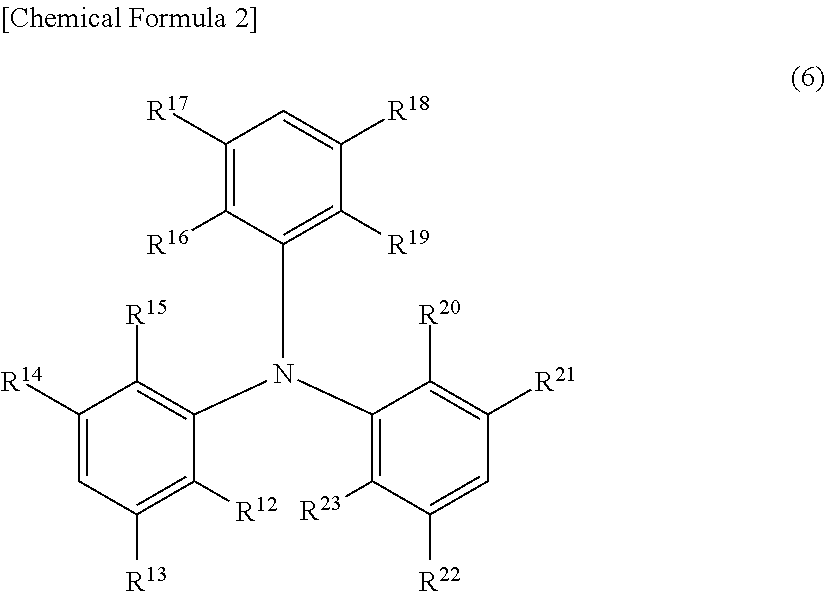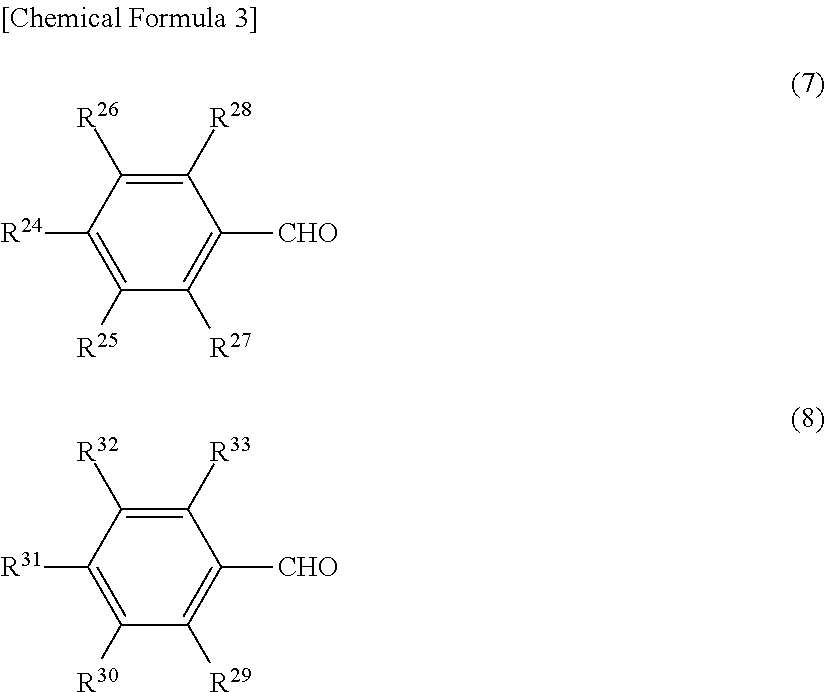Charge-transporting varnish
a technology of charging varnish and charging layer, applied in the direction of electricly conductive paints, coatings, luminescent compositions, etc., can solve the problem that two layers usually need additional steps, and achieve the effect of improving luminance characteristics and durability, high yield, and simplifying the manufacturing process
- Summary
- Abstract
- Description
- Claims
- Application Information
AI Technical Summary
Benefits of technology
Problems solved by technology
Method used
Image
Examples
synthesis example 1
[0164]
[0165]A solution containing N,N-dimethylformamide (84 mL) in carbazole (8.36 g, 50 mmol) and 2-ethylhexyl bromide (8620 μL, 50 mmol) was prepared. After cooling to 0° C., the solution was given sodium hydride (60% in liquid paraffin) (2.62 g, 60 mmol). The resulting solution was heated to room temperature and stirred for 18 hours. The reaction solution was quenched by addition of water and then extracted with ethyl acetate. The organic layer was dried with sodium sulfate and then freed of solvent by concentration under reduced pressure. The thus obtained crude product was purified by silica gel column chromatography (eluted with hexane), followed by solvent removal by concentration under reduced pressure. Thus, there was obtained N-(2-ethylhexyl)carbazole (9.60 g).
[0166]1H-NMR (300 MHz, CDCl3):
[0167]δ0.84-0.93 (m, 6H), 1.23-1.41 (m, 8H), 2.05-2.09 (m, 1H), 4.13-4.21 (m, 2H), 7.17-7.25 (m, 2H), 7.38-7.48 (m, 4H), 8.10 (dd, J=0.9, 7.8 Hz, 2H).
synthesis example 2
Synthesis of Polymer 1
[0168]
[0169]The process was started by adding 1,4-dioxane (30 g) to triphenylamine (11.04 g, 45 mmol), N-TEG carbazole derivative synthesized by the method described in Synthetic Metals, 89(3), 171 (1997) (4.70 g, 15 mmol), 4-trifluoromethylbenzaldehyde (0.823 g, 6.3 mmol), 9-fluorenone (7.66 g, 56.7 mmol), and p-toluenesulfonic acid (11.95 g, 60 mmol). The resulting mixture was heated to 110° C. and stirred for three hours at this temperature. After cooling to room temperature, the reaction product was diluted with tetrahydrofuran (10 mL). The resulting diluted solution was added dropwise to a mixture of methanol (800 mL) and 28% ammonia water (100 mL), followed by stirring for 30 minutes. The resulting solution was filtered by suction to recover precipitated powder. The recovered powder was dissolved in tetrahydrofuran (80 mL). The resulting solution was added dropwise to methanol (800 mL), followed by stirring for 30 minutes. The resulting solution was filte...
synthesis example 3
Synthesis of Polymer 2
[0172]
[0173]The process was started by adding 1,4-dioxane (5 g) to triphenylamine (1.84 g, 7.5 mmol), N-ethylhexylcarbazole (0.70 g, 2.5 mmol) obtained in Synthesis Example 1, 4-trifluoromethylbenzaldehyde (134 μL, 1 mmol), 9-fluorenone (1.62 g, 9 mmol), and p-toluenesulfonic acid (1.90 g, 10 mmol). The resulting mixture was heated to 110° C. and stirred for four hours at this temperature. After cooling to room temperature, the reaction product was diluted with tetrahydrofuran (5 mL). The resulting diluted solution was added dropwise to a mixture of methanol (125 mL) and 28% ammonia water (25 mL), followed by stirring for 30 minutes. The resulting solution was filtered by suction to recover precipitated powder. The recovered powder was dissolved in tetrahydrofuran (40 mL). The resulting solution was added dropwise to methanol (125 mL), followed by stirring for 30 minutes. The resulting solution was filtered by suction to recover precipitated powder. After dryin...
PUM
| Property | Measurement | Unit |
|---|---|---|
| charge-transporting | aaaaa | aaaaa |
| electroluminescence | aaaaa | aaaaa |
| area | aaaaa | aaaaa |
Abstract
Description
Claims
Application Information
 Login to View More
Login to View More - R&D
- Intellectual Property
- Life Sciences
- Materials
- Tech Scout
- Unparalleled Data Quality
- Higher Quality Content
- 60% Fewer Hallucinations
Browse by: Latest US Patents, China's latest patents, Technical Efficacy Thesaurus, Application Domain, Technology Topic, Popular Technical Reports.
© 2025 PatSnap. All rights reserved.Legal|Privacy policy|Modern Slavery Act Transparency Statement|Sitemap|About US| Contact US: help@patsnap.com



